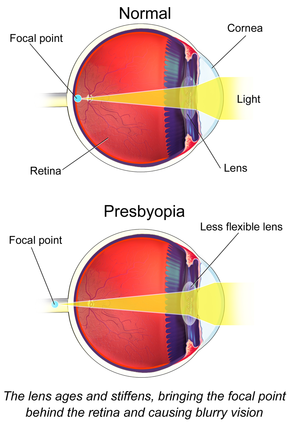Presbyopia
Presbyopia is a physiological insufficiency of optical accommodation associated with the aging of the eye; it results in progressively worsening ability to focus clearly on close objects.Scuba divers with interest in underwater photography may notice presbyopic changes while diving before they recognize the symptoms in their normal routines due to the near focus in low light conditions.Myopes considering refractive surgery are advised that surgically correcting their nearsightedness may be a disadvantage after age forty, when the eyes become presbyopic and lose their ability to accommodate or change focus, because they will then need to use glasses for reading.Monovision can be created with contact lenses, so candidates for this procedure can determine if they are prepared to have their corneas reshaped by surgery to cause this effect permanently.[citation needed] The cause of presbyopia is lens hardening by decreasing levels of α-crystallin, a process which may be sped up by higher temperatures.This is consistent with the fact that our eyes seem to be in the 'relaxed' state when focusing at infinity, and also explains why no amount of effort seems to enable a myopic person to see farther away.Solutions for presbyopia have advanced significantly in recent years due to widened availability of optometry care and over-the-counter vision correction options.[16] Other side effects of multifocal corneal ablation include postoperative glare, halos, ghost images, and monocular diplopia.[18] A number of studies have claimed improvements in near visual acuity by the use of training protocols based on perceptual learning and requiring the detection of briefly presented low-contrast Gabor stimuli; study participants with presbyopia were enabled to read smaller font sizes and to increase their reading speed.
Old Eyes (album)SpecialtyOptometryophthalmologySymptomseyestrainlens of the eyeDiagnostic methodEye examEyeglassescontact lensesaccommodationheadachesrefractive errorshypermetropiaciliary muscleretinanearsightednessfarsightednessastigmatismeye examinationglassesmultifocal intraocular lensesconvex lensbifocalsprogressive lensesfocal ratiodepth of fieldphotographymioticpupilsScuba diversunderwater photographynear-sightednessrefractive surgeryaccommodatemonovisionAccommodation (vertebrate eye)near pointdioptersopticsmagnifying glasseszonulamyopicdioptresCorrective lensesvisual acuitydiplopiaperceptual learningPilocarpineAncient GreekromanizedAristotleMarquette, MIBibcodeMedLineDiseasesDBSNOMED CTMedlinePluseMedicineDiseases of the human eyeAdnexaEyelidChalazionBlepharitisMeibomian gland dysfunctionEntropionEctropionLagophthalmosBlepharochalasisPtosisBlepharophimosisXanthelasmaAnkyloblepharonEyelashTrichiasisMadarosisDistichiasisTrichomegalyLacrimal apparatusDacryoadenitisEpiphoraDacryocystitisXerophthalmiaExophthalmosEnophthalmosOrbital cellulitisOrbital lymphomaPeriorbital cellulitisConjunctivaChemosisConjunctivitisallergicPterygiumPseudopterygiumPingueculaSubconjunctival hemorrhageFibrous tunicScleraScleritisEpiscleritisCorneaKeratitisherpeticacanthamoebicfungalExposurePhotokeratitisCorneal ulcerThygeson's superficial punctate keratopathyCorneal dystrophyFuchs'MeesmannCorneal ectasiaKeratoconusPellucid marginal degenerationKeratoglobusTerrien's marginal degenerationPost-LASIK ectasiaKeratoconjunctivitisCorneal opacityCorneal neovascularizationKayser–Fleischer ringHaab's striaeArcus senilisBand keratopathy